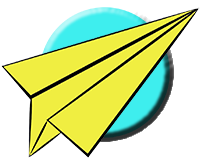Crazy Galleon Paper Airplane
Crazy Galleon Paper Airplane
Instructions
1. Fold the upper left corner down so the upper left point hits the right edge of the paper. When folded correctly, the top edge should line up with the right edge of the paper. Unfold after the crease has been made.
2. Fold the upper right down so the upper right point hits the left edge of the paper. When folded correclty, the top edge should line up with the left edge of the paper. Unfold after the crease has been made.
3. Flip the paper over keeping the previously created creases towards the top.
4. Fold the top edge down so the upper left and right points created by the diagonal creases towards the bottom of the paper. The new horizontal crease should go through the center point. Unfold after the crease has been made.
5. Flip the paper over keeping the creases towards the top.
6. Fold the paper exactly in half about its long edge. Unfold after the crease has been made.
7. Pop the left and right points at the ends of the horizontal crease up and bring them in towards the center about the existing diagonal creases. Bring the top edge over and down pressing the fold flat.
8. Fold the tip of the nose down so the top point hits the center line crease. When folded correctly, the tip of the nose should be about one finger width below the layers of paper in the middle of the page.
9. Unfold the crease just made.
10. Flip the paper over keeping the nose at the top.
11. Fold the tip of the nose down about the existing crease created by the previous fold.
12. Flip the paper over and rotate it around so the nose flap is underneath and the nose points to the right.
13. Pop the top-most layer of paper up and bring it over about the existing crease. Bring the two middle points from the second layer out and down so they hit the crease line about which the top layer is folding. Two new creases are created on each side of the second layer.
14. Rotate the plane around so the nose is at the top.
15. Fold the top edge down so the top middle point hits the center line crease. The new crease should be parallel to the top edge and should be about one finger width down from the top edge.
16. Fold the top edge over on top of itself. The new crease should be parallel to the top edge and should be tight against the previous fold. This fold should not overlap the other layers of paper in the middle of the page.
17. Fold the upper left corner over so the upper left point hits the bottom edge of the top-most flap. When folded correctly, the upper left edge should line up with the bottom edge of the flap.
18. Fold the upper right corner over so the upper right point hits the bottom edge of the top-most flap. When folded correctly, the upper right edge should line up with the bottom edge of the flap.
19. Fold the top edge over so the top middle point hits the center line crease. The new crease should be at the base of the top-most flap.
20. Flip the plane over and rotate it around so the nose points to the right.
21. Fold the plane exactly in half about the existing center line crease. Be sure to line up the sides for good balance.
22. Rotate the plane around so the nose points to the left and the wing flaps are up.
23. Make a crease for the first wing flap. The new crease should be parallel to the bottom edge of the fuselage and should be about one finger width up from the bottom edge. The left point of the crease should be at the top of the nose tip.
24. Flip the plane over and rotate it around so the first wing flap is underneath and the nose points to the right.
25. Make a crease for the second wing flap. Be sure to line up the wing flaps for good balance.
26. Unfold the wing flaps and adjust the wing angles so they are even. set the dihedral flat or slightly up. The addition of a piece of tape, a staple, or a paper clip near the nose will add stability and distance to the flights.
THE THROW Launch with a moderate level throw if trimmed normally. Try making vertical stabilizers either up or down at the ends of either the front or rear wing tips. Flights can get more acrobatic and interesting depending on the experimental flaps you create.
